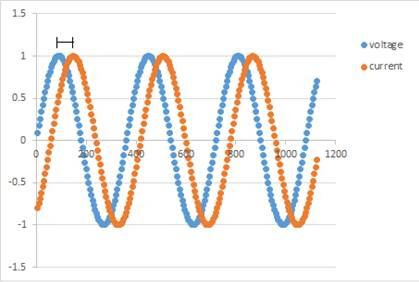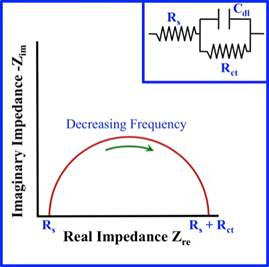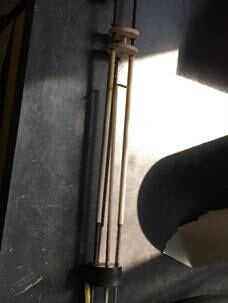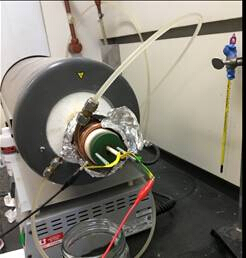Espectroscopia de Impedância Eletroquímica
Visão Geral
Fonte: Kara Ingraham, Jared McCutchen, e Taylor D. Sparks, Departamento de Ciência e Engenharia de Materiais, Universidade de Utah, Salt Lake City, UT
Resistência elétrica é a capacidade de um elemento de circuito elétrico resistir ao fluxo de eletricidade. A resistência é definida pela Lei de Ohm:
 (Equação 1)
(Equação 1)
Onde  está a tensão e é a
está a tensão e é a  corrente. A lei de Ohm é útil para determinar a resistência dos resistores ideais. No entanto, muitos elementos de circuito são mais complexos e não podem ser descritos apenas pela resistência. Por exemplo, se uma corrente alternada (AC) for usada, então a resistividade dependerá muitas vezes da frequência do sinal CA. Em vez de usar apenas a resistência, a impedância elétrica é uma medida mais precisa e generalizada da capacidade de um elemento de circuito de resistir ao fluxo de eletricidade.
corrente. A lei de Ohm é útil para determinar a resistência dos resistores ideais. No entanto, muitos elementos de circuito são mais complexos e não podem ser descritos apenas pela resistência. Por exemplo, se uma corrente alternada (AC) for usada, então a resistividade dependerá muitas vezes da frequência do sinal CA. Em vez de usar apenas a resistência, a impedância elétrica é uma medida mais precisa e generalizada da capacidade de um elemento de circuito de resistir ao fluxo de eletricidade.
Mais comumente, o objetivo das medidas de impedância elétrica é a desconvolução da impedância elétrica total de uma amostra em contribuições de diferentes mecanismos, como resistência, capacitância ou indução.
Princípios
Durante a Espectroscopia de Impedância Eletroquímica (EIS) uma tensão CA é aplicada a uma amostra em diferentes frequências e a corrente elétrica é medida. Ao lidar com a impedância das correntes ac  () substitui a resistência (
() substitui a resistência (  ) na lei de Ohm. Se o sinal CA original for sinusoidal, então uma resposta linear significa que a corrente produzida também será sinusoidal, mas deslocada em fase. A contabilização da frequência e mudança de fase da tensão e da corrente é mais facilmente realizada utilizando a relação de Euler e números complexos onde temos um componente real e imaginário para
) na lei de Ohm. Se o sinal CA original for sinusoidal, então uma resposta linear significa que a corrente produzida também será sinusoidal, mas deslocada em fase. A contabilização da frequência e mudança de fase da tensão e da corrente é mais facilmente realizada utilizando a relação de Euler e números complexos onde temos um componente real e imaginário para  . A partir disso podemos construir equações para impedância para diferentes componentes de um circuito:
. A partir disso podemos construir equações para impedância para diferentes componentes de um circuito:
1.Resistor:  (Equação 2)
(Equação 2)
2.Capacitores:  (Equação 3)
(Equação 3)
3.Indutor:  (Equação 4)
(Equação 4)
Onde  está a frequência da corrente CA,
está a frequência da corrente CA,  é a capacitância, é a
é a capacitância, é a  indutância, e é a unidade
indutância, e é a unidade  imaginária. A partir dessas equações você pode ver que a impedância como resistor é independente da frequência, inversamente relacionada à frequência como capacitor, e frequência diretamente relacionada como um indutor.
imaginária. A partir dessas equações você pode ver que a impedância como resistor é independente da frequência, inversamente relacionada à frequência como capacitor, e frequência diretamente relacionada como um indutor.
Uma trama de Nyquist é gerada a partir da resposta de frequência à impedância elétrica, plotando o componente imaginário no eixo y e o componente real no eixo x. O instrumento aplica uma tensão de campo alternada à amostra e mede a resposta atual. Os componentes reais e imaginários da impedância são calculados determinando a mudança de fase e a mudança na amplitude em diferentes frequências. Um exemplo disso é mostrado na Figura 1. Este enredo é então usado para construir um modelo de circuito que melhor representa a impedância da amostra.

Figura 1: Uma representação do turno de fase entre a tensão aplicada e a corrente medida.
Uma das parcelas mais simples de Nyquist é a de um semi-círculo que pode ser visto na Figura 2. O enredo na Figura 2 é representado por um resistor em série seguido por um resistor e capacitor em paralelo - isso é conhecido como modelagem de circuito equivalente. Diferentes processos físicos correspondem a elementos no modelo de circuito; por exemplo, uma camada dupla elétrica corresponde a um capacitor. Na Figura 2, uma trama de Nyquist é mostrada que é melhor modelada por uma célula Randle. Este é um lugar de partida comum para a interpretação de um enredo de Nyquist. Depois que o lote nyquist estiver completo, o software lhe apresentará modelos de circuito equivalentes que você pode escolher para modelar seus dados. Se o gráfico nyquist não tiver um bom ajuste a partir dos ajustes gerados pelo computador, você pode construir seu próprio circuito para se adequar aos dados. No entanto, esta pode ser uma tarefa complicada. É importante começar simples e construir a partir daí. Também é importante permanecer realista com base no que você sabe sobre a amostra que você está testando, para garantir que você não construa um modelo irreal. Para começar, se o primeiro ponto está no eixo real, é comumente modelado como um resistor. À medida que você se move ao longo da curva, você pode adicionar ou remover elementos do circuito para gerar um ajuste melhor.

Figura 2: Imagem de um simples Gráfico Nyquist e seu modelo de célula Randle equivalente.
O conceito que planejamos modelar neste experimento é como testar amostras com EIS e usar o enredo nyquist para construir um circuito de modelo que possa representar os dados de impedância observados. Para a primeira parte do experimento, demonstraremos como executar uma amostra de controle que produz um modelo de circuito conhecido que o software pode facilmente reconhecer. Para a segunda parte, podemos demonstrar como testar uma amostra experimental e novamente usar o software para gerar um circuito de modelos os melhores modelos da impedância elétrica da amostra.
Procedimento
- Obtenha um módulo de teste e conecte-o aos instrumentos EIS através de dois eletrodos. O módulo de teste, retratado na Figura 3,fornece dados que podem ser usados para modelar um circuito simples e conhecido. Pode ser usado para confirmar que os fios estão ligados à máquina corretamente e que todas as peças de máquinas estão funcionando.

Figura 3: Módulo de teste.
- Para começar a fluir corrente através da amostra, abra o software Zplot no computador. A partir deste software você pode configurar os parâmetros para sua amostra conforme necessário. Ao executar um teste no módulo de teste, em "Polarização", defina o Potencial DC para 0, AC Amplitude para 10 mV e certifique-se de que a seta solta diz: "vs. Circuito Aberto". Sob a seção "Varredura de frequência", defina a frequência inicial para 1x10^6 Hz, a frequência final para 100 Hz, e intervalo para 10. Selecione também "logarítmico" e "Passos/Década". Em seguida, pressione "ok" para começar uma nova leitura.
- Abra o software Zview para visualizar os resultados. Selecione z' e z'' para plotar. Os resultados serão mostrados no eixo negativo para mostrá-los no eixo positivo, multiplicar-se por -1. Clique em "medir" e depois "varrer" para obter os valores medidos z' e z'' Compare esses valores medidos com os valores esperados encontrados na parte frontal do módulo de teste, conforme visto na Figura 2. Se os valores coincidirem, continue a etapa 4. Caso não, verifique toda a fiação e equipamento para ver se tudo está conectado e funcionando corretamente.
- Retire os eletrodos do módulo de teste.
- Prepare a amostra; para demonstração, usaremos uma alumina beta comercialmente disponível colocando-a na montagem mostrada na Figura 4. Insira este conjunto no forno do tubo, que está localizado na fumaça do capô. Esta configuração é necessária porque os testes EIS geralmente são executados por amplitude (ou tensão) variadas e temperatura ao longo de um determinado período de tempo. Para simplificação, vamos executar este experimento apenas em temperatura ambiente.

Figura 4: Montagem em que a amostra será inserida.
- Conecte os eletrodos ao conjunto conforme mostrado na Figura 5.

Figura 5: Conjunto amostral, na fumaça do capô, com eletrodos ligados.
- Abra o software Zplot e defina os parâmetros. Para este experimento, os parâmetros serão os mesmos que estavam na etapa 2.
- Obtenha as parcelas utilizando o mesmo procedimento da etapa 3 (exceto que os valores z' e z'' não precisam ser comparados ao módulo de teste). Guarde as tramas.
- Clique no botão "ajuste instantâneo" e escolha dois pontos para se encaixar no semi-círculo. Use o software para escolher o melhor modelo de circuito equivalente.
Resultados
Os resultados do EIS são frequentemente apresentados em uma trama de Nyquist, que mostra impedância real versus impedância complexa em cada frequência testada. O enredo do experimento correu pode ser visto na Figura 6.

Figura 6: Captura de tela do computador após a ção de Nyquist ser obtida.
Como visto na etapa 9 do procedimento, o software lhe dará opções de circuitos para modelar seus dados. É melhor escolher o modelo mais simples que ainda reflete com precisão os dados. Escolher o circuito correto para modelar os dados é um problema difícil e inverso. Embora existam pacotes de software que possam auxiliar na geração de circuitos de modelos, deve-se tomar cuidado durante esta análise.
Quando um circuito equivalente é escolhido, os dados resultantes podem ser usados para calcular a condutividade da amostra. Uma maneira de calcular condutividade é traçar os dados do EIS usando um modelo Arrhenius, que plota 1000/T no eixo x e log(σT) no eixo y. Os dados podem ser ajustados a uma linha linear usando a seguinte equação:
 (Equação 5)
(Equação 5)
Onde  para nossa amostra foram 374 S/cm*K e Ea, a energia de ativação, foi de 0,17 eV, e T = 298 K. Conectando esses valores, calculamos uma condutividade de 1,67 x 10-3 S/cm. Experimentos anteriores com esta amostra relataram que sua condutividade era de aproximadamente 4,1 x 10-3 S/cm. Isso é bastante semelhante ao valor de condutividade que calculamos, indicando que o modelo que escolhemos era um bom, embora não perfeito, adequado.
para nossa amostra foram 374 S/cm*K e Ea, a energia de ativação, foi de 0,17 eV, e T = 298 K. Conectando esses valores, calculamos uma condutividade de 1,67 x 10-3 S/cm. Experimentos anteriores com esta amostra relataram que sua condutividade era de aproximadamente 4,1 x 10-3 S/cm. Isso é bastante semelhante ao valor de condutividade que calculamos, indicando que o modelo que escolhemos era um bom, embora não perfeito, adequado.
Aplicação e Resumo
A Espectroscopia de Impedância Eletroquímica é uma ferramenta útil para determinar como um novo material ou dispositivo impede o fluxo de eletricidade. Ele faz isso aplicando um sinal CA através dos eletrodos conectados à amostra. Os dados são coletados e plotados pelo computador na planície complexa. Com a ajuda do software, o gráfico pode ser modelado após partes específicas de um circuito. Esses dados muitas vezes podem ser muito complicados e requer uma análise cuidadosa. Esta técnica, por mais complexa que seja, é um meio não destrutivo extremamente útil de interrogar as complexidades do mundo real da impedância elétrica, e pode fornecer modelos úteis de como a corrente CA se comporta quando aplicada à amostra.
O EIS pode ser usado para olhar microrganismos em uma amostra. Quando as bactérias crescem em uma amostra, ela pode alterar a condutividade elétrica da amostra. Usando essa ideia, você pode medir a impedância de uma amostra em uma frequência para determinar a população de microrganismos. Esta técnica é conhecida como microbiologia de impedância.
O EIS também pode ser usado para testar câncer em tecidos, conhecido como Impedância Elétrica tecidual. A impedância elétrica do tecido corporal é determinada por sua estrutura. À medida que se degrada com o tempo, sua impedância da corrente elétrica também muda. Assim como a microbiologia da impedância, esse tipo de teste de impedância olha para a população das células e pode fornecer informações úteis sobre saúde celular e morfologia.
O EIS também é usado nas indústrias de prevenção de tinta e corrosão para determinar o quão bem uma camada é aplicada à superfície de um material. Os dados do EIS correspondem bem aos processos eletroquímicos cotidianos que atacam superfícies; materiais que mostram uma resistência elétrica menor do que  podem não proteger contra corrosão, bem como materiais com maior resistência. O EIS é um caminho para prever como novos tratamentos superficiais serão justos em ambientes severos sem ter que recriá-los, tornando-se uma ferramenta inestimável na prevenção da corrosão que, de outra forma, custaria aos Estados Unidos bilhões de dólares em reparos a cada ano.
podem não proteger contra corrosão, bem como materiais com maior resistência. O EIS é um caminho para prever como novos tratamentos superficiais serão justos em ambientes severos sem ter que recriá-los, tornando-se uma ferramenta inestimável na prevenção da corrosão que, de outra forma, custaria aos Estados Unidos bilhões de dólares em reparos a cada ano.
Tags
Pular para...
Vídeos desta coleção:

Now Playing
Espectroscopia de Impedância Eletroquímica
Materials Engineering
23.4K Visualizações

Materialografia Óptica Parte 1: Preparação da Amostra
Materials Engineering
15.5K Visualizações

Materialografia Óptica Parte 2: Análise de Imagens
Materials Engineering
11.1K Visualizações

Espectroscopia de fotoelétrons de raios-X
Materials Engineering
21.8K Visualizações

Difração de raios X
Materials Engineering
89.2K Visualizações

Feixes de Íons Focalizados
Materials Engineering
8.9K Visualizações

Solidificação Direcional e Estabilização de Fase
Materials Engineering
6.6K Visualizações

Calorimetria exploratória diferencial
Materials Engineering
38.0K Visualizações

Difusividade Térmica e Método do Flash de Laser
Materials Engineering
13.3K Visualizações

Galvanoplastia de filmes finos
Materials Engineering
20.2K Visualizações

Análise da Expansão Térmica via Dilatometria
Materials Engineering
15.9K Visualizações

Materiais Compósitos de Matriz Cerâmica e Suas Propriedades de Flexão
Materials Engineering
8.3K Visualizações

Ligas Nanocristalinas e Estabilidade de Tamanho de Nano-grão
Materials Engineering
5.2K Visualizações

Síntese de hidrogéis
Materials Engineering
23.8K Visualizações
Copyright © 2025 MyJoVE Corporation. Todos os direitos reservados